![[Swiss flag at sea]](../images/c/ch~pant.gif)
![[Swiss flag]](../images/c/ch_pant.gif) images by Zoltan Horvath, 21 October 2024
images by Zoltan Horvath, 21 October 2024
Last modified: 2025-11-22 by martin karner
Keywords: switzerland | sea merchant flags | naval flags | naval | navy | rectangular flag |
Links: FOTW homepage |
search |
disclaimer and copyright |
write us |
mirrors
![[Swiss flag at sea]](../images/c/ch~pant.gif)
![[Swiss flag]](../images/c/ch_pant.gif) images by Zoltan Horvath, 21 October 2024
images by Zoltan Horvath, 21 October 2024
See also:

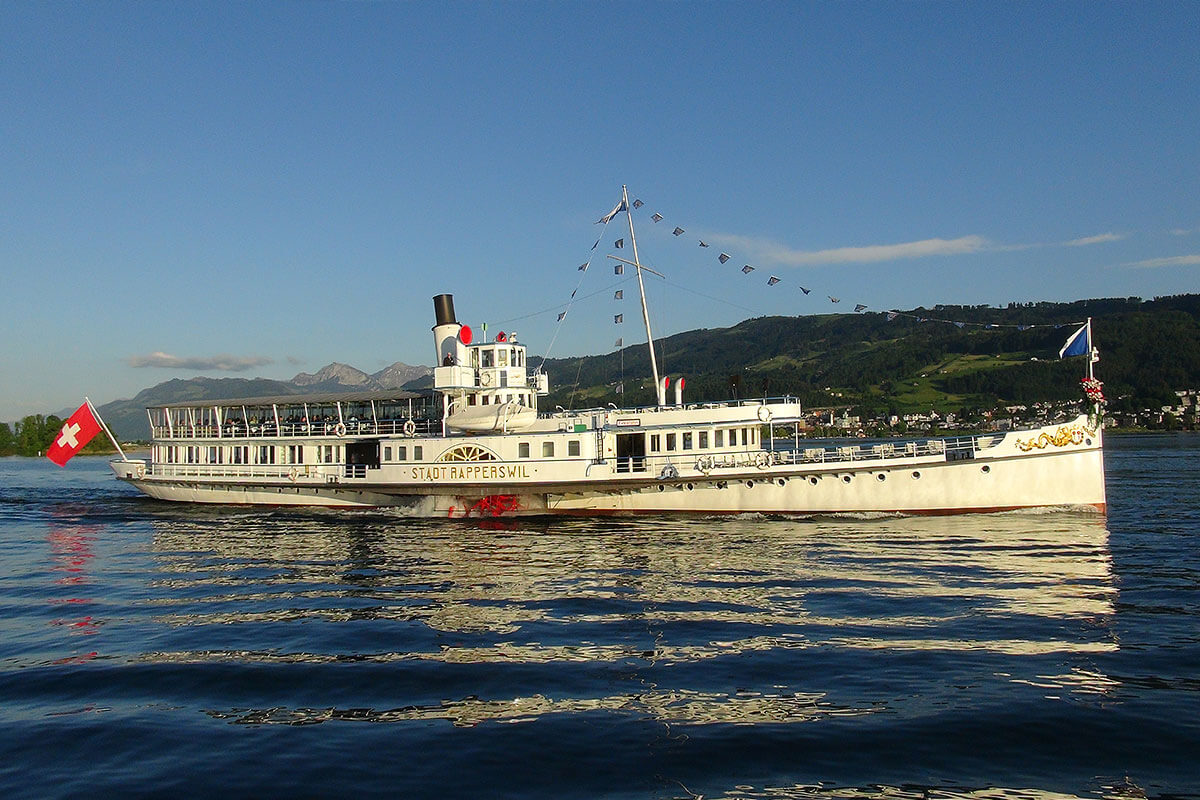
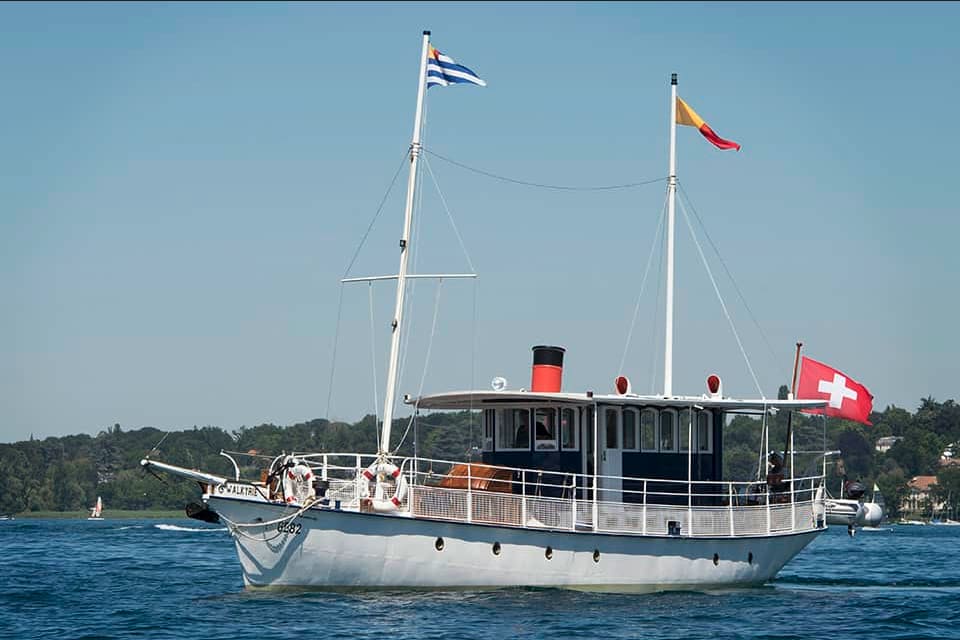
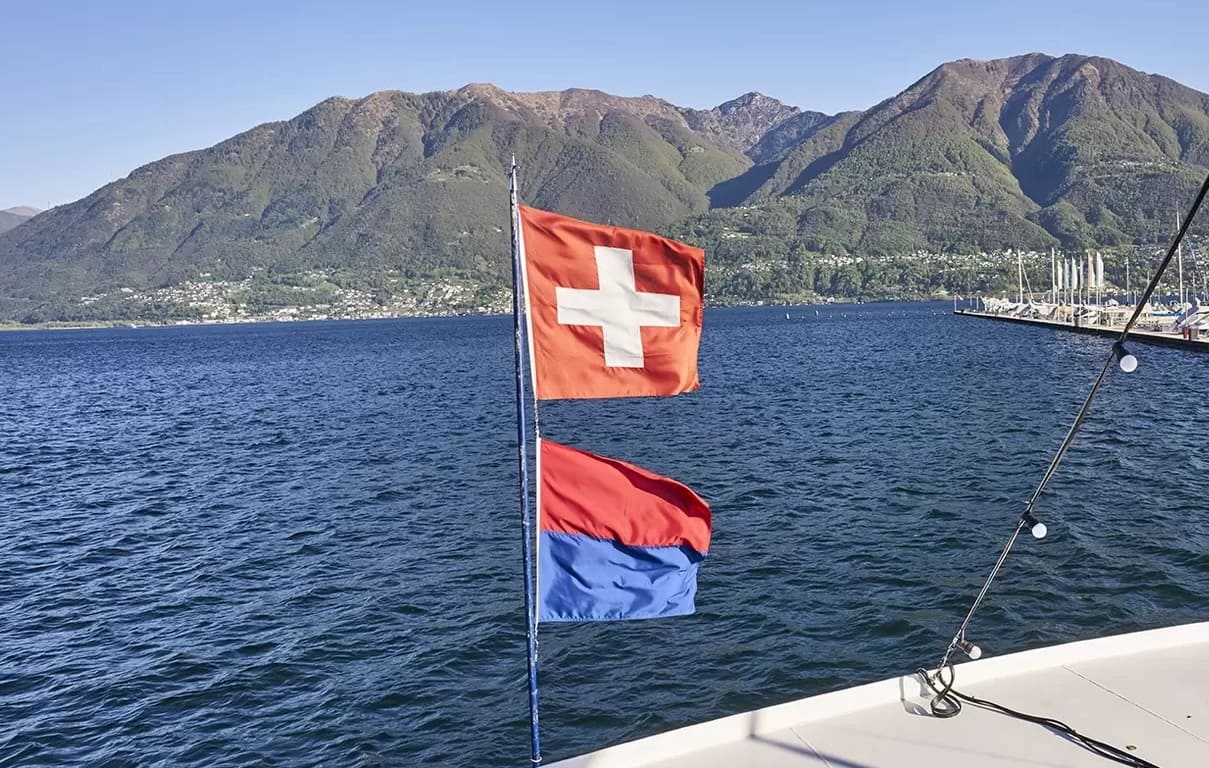
DS Schiller (source)
DS Stadt Rapperswil (source)
(source)
(source)
images located by Martin Karner
During WWII a Swiss Naval Ensign was adopted with the proportions 2:3.
The National Flag of Switzerland is square.
Nick Artimovich, 12 February 1996
It is used only by the Swiss
commercial fleet outside Switzerland. On the lakes the usual square flag
is used.
Harald Müller, 12 February 1996
Even if landlocked, Switzerland has its ships mainly to sail on the
different lakes like Lake Constance (Bodensee), Lake Leman (or Lake Geneva but
people outside of Geneva dislike this spelling), Lake Brienz, Lake Thun, Lake Lucerne
(Vierwaldstättersee), Lake Zug, Lake Neuchatel, Lake Biel/Bienne or Lake Morat
(Murten) to name a few, but they belong to private navigation
companies. There's no regulation as to which flag or ensign should be flown on
these ships: It appears that 2:3 ensigns are only flown on the three main
lakes of Switzerland (Constance, Geneva and Zurich) while ships on
other smaller lakes fly the 1:1 flag.
Pascal Gross, 11 July 2002
Lake Maggiore and Lake Lugano form international borders with Italy. The shipping company for Lake
Maggiore is Italian and they seem to fly only the Italian flag. The shipping company for Lake Lugano is
located in Switzerland and the square flag is flown here.
Pascal Gross, 12 July 2002
I have visited two of the Swiss lakes and (bearing in mind that it was over twenty years ago) the flags
flown by the commercial vessels which plied those lakes were definitely 2:3.
Christopher Southworth, 21 March 2009
This seems to be correct for at least some of the vessels – see
here [postcard from early 20th century, Lake Constance, see Emil Dreyer's comment below]
and here
– but not all of them – see here [picture].
Joe McMillan, 21 March 2009
See possibly Meylan (1974). I seem to
remember that the situation is a bit difficult, and somewhat different from lake
to lake, so there is no simple rule, and definitely no straightforward
legislation, but only some custom.
M. Schmöger, 30 March 2009
As we all know, Swiss sea-going ships are entitled by the law of 9 April 1941
(effective as of 17 April 1941) to use the rectangular national flag. Swiss
ships on the lake of Constance had used a rectangular flag of 2:3 as early as
1911 (Lake Constance steamship company regulations of 15 January 1911; see postcard
from early 20th c., steamship "Rhein" on Lake Constance), but they
were the only Swiss ships to use such a flag shape until 1941.
The law of
1941 was passed because during WWII it was necessary to distinguish the few
Swiss ships carrying supplies home, not to be seized or torpedoed by war-faring
powers. The internationally recognised ratio of 2:3, estimated to be the usual
maritime type of flag, was chosen. Those ships not only wore the rectangular
Swiss flag, but had large square (sic!) Swiss flags painted at the sides and on
top of the ships.
In fact, the construction sheet of this rectangular
Swiss flag is the only official drawing of a Swiss national flag so far. This
specific flag is officially denominated "national flag at sea" (Schweizerflagge
zur See), whereas the square national flag has no official name at all, it is
indifferently called the "federal flag" (Bundesfahne), the "confederate flag"
(eidgenössische Fahne), the "national flag" (Nationalfahne) or the "flag of the
country" (Landesfahne).
The first and only official mention of a Swiss
national flag is to be found in the constitution of 1848 (article 20, point 5),
where it simply says that "all troops in confederate service fly the confederate flag"
(Alle Truppenabteilungen im eidgenössischen Dienste führen die eidgenössische
Fahne). Only in 1851 is this flag described in a military regulation about
uniforms and equipment (regulation of 27 August 1851), in article 62 it says: "... each infantry batallion has a flag with the colours of the confederation,
the white cross on red field ...".
That's all what ever was regulated about
the Swiss national flag during the last 158 years. The actual Swiss constitution
has no mention to a national flag, there is obviously no need to mention what
has always been. There is no regulation as to the shape of the flag (of course
it is square, but this is said nowhere), as to the size of the cross in respect
to the field, nor as to the shade of red or white.
Only the proportion of the
cross has been regulated on 12 December 1889, to amend the regulation of 14 July
1815, whereby "... the red field should contain a freely standing upright white
cross, its arms being each one sixth longer than broad". So it has remained
until today.
Now back to the rectangular Swiss national flag. As I said,
ships on Lake Constance wear this rectangular flag 2:3 since 1911, sea-going
Swiss ships wear it since 1941. A regulation of 15 March 1971 introduced the use
of emblems to be placed on the rectangular Swiss flag "as long as it does
not be mistaken with any other foreign flag". Nothing is said about where such
emblems should be placed and how big these should be, etc. Usually such emblems
are placed in the upper hoist corner, following the example of the Cruising Club
of Switzerland, which had adopted its flag as early as 1956 (but which was not
allowed to use it as a national flag until 1971).
There are no official
government regulations for the use of rectangular flags on Swiss lakes and
rivers, usually though yachts and boat owners use the rectangular flags. I say
usually, because square flags are seen quite often too. Swiss ships on lake
Geneva, on lake Lugano and on lake Maggiore (lakes having a boundary to France
and Italy respectively) started using rectangular flags very early, but after
1941. Somewhat later followed the ships on lake Neuchâtel. I do not know the
exact dates of adoption of the use of rectangular flags by the steamship or
motorboat companies on those lakes. I have this research on my mind since 30
years ...
Each person or company is entitled to use the flag of individual
preference. Swiss flags on ships cruising on little lakes (like those of Zurich,
Hallwyl, Sempach, Zug, the Walensee, Ägeri, Thun, Biel, Murten, Brienz) are usually
square, as are those on the Lake of Lucerne. It seems as those regions in the
interior are more conservative and of course they have less maritime traditions
than when you live at those lake shores where you can see foreign ships.
The lack of clear regulations on the Swiss flag is on one side an expression
of liberty of the individual citizen. The Swiss identity is immediately
recognised, whatever shape the flag should have, and you can't show it upside
down. So there's no need for regulations, the flag has always been a white cross
on red, that's it. There is no government pursuit of offenses to the flag,
either by burning or soiling, or flying a square or rectangular or dark red or
bright red flag, the flag is the flag of every citizen, it has no political,
religious, cultural or ethnic burden.
Only the military have a strict
regulation to the use of the flag (i.e. colour). Government should have a
serious use of the flag too, but sometimes even officials use rectangular flags
instead of the square one (like it used to be flown on government cars until I
insisted in the new flag regulation of 2008 that only square flags had to be
used).
On the other hand, lack of regulation drives vexillologists crazy
:-)
Emil Dreyer, 30 March 2009
In the Dutch harbour of Sneek pleasure craft ships had hoisted rectangular Swiss ensigns.
Sneek is an inland harbour, and at least one of the craft flew a Basel flag
(as a hoist; should have been the jack). In all, that tells us that they could have reached us inland,
suggesting the Swiss rectangular ensigns are not necessarily limited to sea-going vessels or local Swiss
water ways only.
Peter Hans van den Muijzenberg, 18 May 2023
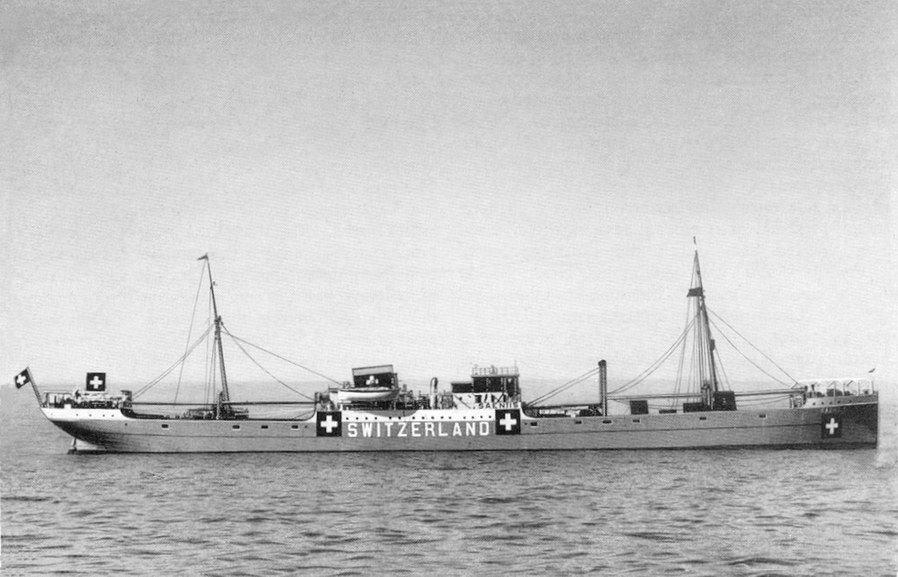
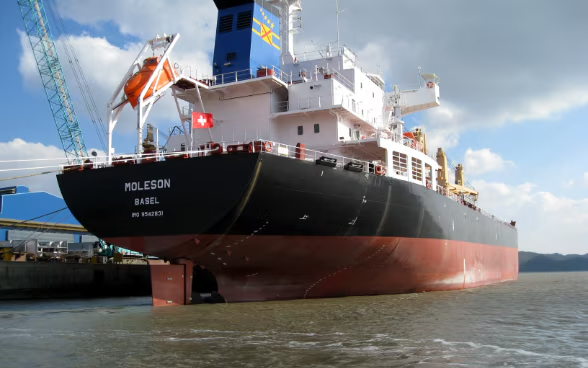
MS Saentis (with WW2 markings and rectangular ensign)
MS Moleson (source)
(source)
One of three extracts from a memorandum sent to the Marine Department of the Board of
Trade in connection with revisions to the pages of national ensigns in the International
Code List published in 1879. [Public Record Office MT 9/183]
Switzerland.
Proposal of the Government of Switzerland to establish a Swiss maritime flag.
1864. "Switzerland has no distinctive maritime flag. Her Majesty's Minister in Berne
observed to the President of the Confederation that in the case where the merchant marine
would not have the protection of a military one, the measure might lead to political
complications in that while the position of Switzerland and her guaranteed neutrality
induced all Foreign Powers under existing circumstances to extend to her citizens
protection and goodwill, yet the use of the flag afloat might bring them into altercations
with belligerent Powers."
The question was referred to Admiral Harris who replied that "HM Government could only
view with satisfaction on the ocean, and in the ports of the British Empire the flag of an
industrious and friendly power, and that in time of peace no question were likely to arise
which would not admit of easy adjustment. However graver questions might arise in time of
war in consequence of Switzerland possessing no port of her own, and from the ships
bearing her flag hailing from ports of a belligerent. Neutrality guaranteed to the
territory of Switzerland could not be held to afford exceptional privileges to the
merchant vessels of Swiss citizens, and the power proposed to be given to Swiss consuls to
register vessels provisionally was considered likely to give rise to grave international
difficulties. The question of enforcement of Swiss municipal law on board such vessels,
and the manner in which respect to the Swiss Flag could be ensured were matters for the
Swiss Government."
Law Officers' Opinion. "The proposal is novel and though Swiss Marine must necessarily be
dependent upon the use of ports of other countries, there is no principle in International
Law which ought to lead other countries to refuse to recognise the flag of an inland
state, when used either by public ships of that state, or by the ships of its subjects
under the authority of its Government upon the high seas."
Proposal adjourned by Swiss Legislature to the following session, and abandoned in 1866.
David Prothero, 17 April 2001
It would seem peculiarly British to suppose that a state needed a distinctive
ensign – different from the national flag – for display at
sea, since most other countries even then used the same flag for both purposes.
The more relevant point is that subsequent treaties including the UN Convention on the Law of the Sea
explicitly recognize the right of landlocked states to use the high seas under their own flags.
Joe McMillan, 17 April 2001
From the swiss-ships.ch website:
« [...] During the 19th century the Swiss government received countless proposals and requests concerning
the official introduction of the Swiss flag at sea. [...] All these groups argued that better control of
the ships and their fate would be possible if they would be able to sail under the Swiss flag. To some
extent this might have been true. However, it would have required an internationally accepted maritime law
to assure a minimum of stability and security for ships belonging to a nation with no direct access to the
sea. Nothing like that was in sight at that time. Every seafaring nation created its own laws and
interpreted them to its advantage. This must have been one of the many reasons why the Swiss government was
not very much interested in this question. However, it asked several of its embassies and consulates in
seafaring nations to submit a report about the feasibility of operating ocean going ships under the Swiss
flag. A similar request was sent out to the foreign offices of 17 seafaring nations. The reports from the
embassies and consulates were mainly sceptical. [...] Finally the Swiss government decided to drop the
matter. [The British stance reported above was atypical.]
During the First World War [...] the Swiss government and some private entrepreneurs tried to negotiate
several charter agreements or outright ownership of ships under neutral flags. [...] In march 1917 the Swiss
Federal Council established a central authority to handle all import and export problems, called FERO. [...]
FERO managed to close a contract with the US War Transport Office ensuring the delivery of grain to
Switzerland via European neutral ports. The cargo was carried on US flag vessels, including even some
sailing ships. The ships were required to carry a stretched out Swiss flag on the foremast. Also the
word "SCHWEIZ" (German for Switzerland) in huge white letters was painted on both sides of the
hull. [...] When the USA entered the war against the Central Powers these ships were of course no more
available. [...] However, after the cease-fire in November 1918 a great number of ships became available
and the blown up freight rates plummeted to a rather low level. [...]
[See also "States Without a Sea-board" at Naval Identity at Sea]
[In the 1930s] the Swiss government realised the urgent need for a small fleet of merchant ships dedicated to carry food
and raw materials exclusively for Switzerland. Only ships under flags of "permanently neutral"
nations could be considered. On 15 September 1939 the Swiss government managed to close a time charter
contract with the Greek Shipping Company Rethymnis & Kulukundis Ltd. in London. It stipulated the leasing of
15 ships under Greek flag for the whole duration of the war starting at the latest in spring 1940. [...]
When Italy declared war on France and England in June 1940 the Mediterranean became inaccessible. Greece
demanded the hand-over of their chartered ships from Switzerland. Finally they agreed to release ten of
their ships for the time being. England stopped all vessels carrying goods for Switzerland, regardless of
their flag, in ports west of Gibraltar. After seven months they were allowed to discharge their cargo at
Iberian ports, mainly Lisbon. The financial losses for Switzerland and the respective shipping companies
went into the millions. At the beginning the freight was transshipped to Genoa or Marseille using small
coasters under Portuguese flag. Later transport over land was also organised, using hundreds of Swiss and
Spanish railroad freight cars or even truck convoys. As the Spanish Railroad gauge was wider than the rail
tracks of Central Europe, all goods had to be transferred again at the Spanish/French border.
Italy had occupied Albania on 7 April 1939 and attacked Greece on the 28 October 1940. Now the Italian
ports were definitely closed for Ships under the Greek flag. It became increasingly difficult to import
sufficient food and other vital goods into Switzerland. The intensifying U-boat war in the North Atlantic
again caused a tremendous shortage of ship's tonnage.
During the summer of 1940 the Swiss Shipping Company (Schweizerische Reederei AG) in Basel had already
purchased two freighters under Panama Flag, the s/s "Calanda" and s/s "Maloja". André
& Co. in Lausanne, an important grain trader (today: Suisse Atlantique SA), also bought a ship under Panama
flag and called it s/s "St. Cergue". Both companies asked the Swiss Government to have the
vessels registered under the Swiss Flag. The Government declined, arguing that there was no urgent need
for doing so and that the administrative efforts and the costs would be prohibitive for such a small fleet.
Also there was of course still no Swiss maritime law.
The threatening military and political developments in Europe however, made the government to finally
change its mind. In January 1941 the Swiss federal council asked Prof. Dr. Robert Haab of Basel to prepare
a draft for a maritime law. [...] The provisional Federal Maritime Law was put into force on 9 April 1941.
There remained only one problem: there were few ships for sale. [...] However, the Swiss had no choice. The
only thing they could do was buying the best vessels they could afford and have them overhauled, refurbished
and made seaworthy. The costs for this endeavour were enormous but considered justified by its urgency. [...]
The ships carried the word "SWITZERLAND" in huge white letters on both sides of the hull. They
were brightly illuminated at night. Also the Swiss flag was reproduced on the superstructure wherever
possible. [...]
It might be mentioned, that in many cases Swiss flag ships managed to pick up survivors from torpedoed and
sinking ships and bring them to safety. During the war years the s/s "Saint Cergue", for instance,
under the expert leadership of Captain Gerber managed to pick up several hundred survivors of torpedoed
ships. [...]
Long before the end of the war in Europe, the question if Switzerland should continue to operate sea going
merchant ships under its own flag in peace time was hotly discussed by the interested parties. In 1943 the
Association of Forwarding and Shipping Agents voiced its fervent opposition. They were afraid to lose a
long-time advantage of favourable freight rates. The association of Swiss Ship Owners was just as firmly
for a continuation of their activities after the war. The Swiss government supported the latters' view as it
considered the political and military future in Europe as highly insecure. [...]
Fortunately, in February 1946, shipping on the Rhine river was resumed, which made it possible to bypass
the [often damaged] railways and roads. The direct transfer of cargo from seaship to rivership in ports like Antwerp and
Rotterdam also eased the load on the seaports' installations. [...]
Naturally the role of a larger and more modern Swiss merchant fleet during peace time had to be redefined.
For the Swiss government the cargo ships under Swiss flag were still seen as a kind of insurance in case of
another armed conflict. Of course it was impossible to predict if, when, where and what would or could
happen. Very few things, if at all, could be planned ahead. One was the availability of a small fleet of
ships with a minimum total carrying capacity. The only other scheme, which was effectively carried out,
aimed at securing a maximum of Swiss crew members aboard the ships in case of war. All Swiss seamen who had
accumulated a certain time and experience at sea and were otherwise considered suitable were registered in
a list. It was drawn up in agreement with the Military authorities and kept at the Swiss Maritime Office.
In the case of a general mobilisation all persons on the list would have been exempted from military service
and were scheduled to join the ships as crew members. [...] »
Henri Walser (first published in SHIPS MONTHLY, April 1999)
Original article
There is no law enforcement regarding unusual Swiss or cantonal flags. Flags may be rectangular, with
faded colours, or with too big or too small crosses, or hung upside down, or two flags on one mast or
whatever vexillological "don'ts" you may find across the country, only because there are no laws
to the contrary. Flag manufacturers are therefore free to produce Swiss flags however they like –
except for the Swiss ensign, which has a construction plan set by law.
Not only does the Swiss government do nothing to prevent the non-maritime use of rectangular Swiss
flags, but the government also uses such flags often in international matters. Official car flags have
become rectangular during the past years to match them better with the mostly rectangular flags of
official visitors. During international meetings abroad the Swiss flag is always rectangular. While this
is understandable from the organisers' or manufacturers' point of view, since they may try to avoid
causing offence to anybody by using flags of different sizes and it is much cheaper to have all flags the
same shape, the use of rectangular Swiss flags on land is not encouraged. The national flag on land is
square and is used by Swiss citizens as such.
Emil Dreyer, 23 May 2002
 image located by Martin Karner
image located by Martin KarnerSwitzerland does have a small navy of sorts. Lakes Constance and
Leman (Geneva) form international frontiers, and their navy consists
of a few patrol craft [which all carry the rectangular national flag]. Switzerland also has a major Rhine
commercial fleet (you can see the Swiss flag flying all the way to the Netherlands),
which have military patrol craft in time of war. Both the navy and air force
are branches of the army (like the infantry and artillery).
T. F. Mills, 12 February 1996
The Swiss Navy consists of ten patrol boats on two lakes that
form international borders (Constance and Leman).
T. F. Mills, 11 July 2002
See also: Swiss Army Flags
RS 747.30. Maritime Traffic Law (23 September 1953). Article 3: Swiss ensign
(Source:
Website of the Swiss government, German /
French /
Italian > Appendix I with specifications for the ensign:
German /
French /
Italian)
![[Swiss ensign, construction sheet]](../images/c/ch~'.gif) image by Ivan Sache, based on figure that accompanied the 1953 law
image by Ivan Sache, based on figure that accompanied the 1953 lawThe flag is a 2:3 rectangle, with A (length) = 1.5B (height). The central element of the cross is a square of side b. The square is placed in the geometrical center of the flag. Each horizontal arm of the cross has a height of b and a length of b+(1/6)b (the cross has the same specifications as in the coat of arms). Similarly, each vertical arm of the cross has a height of b+(1/6)b and a length of b. There is a height of b between the cross and the upper and lower edges of the flag. [The ratio of the size of the cross to the height is 5:8, so that the ratio of cross to flag width is 5:12.]
Ivan Sache, 2 March 2002
RS 747.321.7. Regulation concerning Swiss yachts at sea (15 March 1971). Article 1, Paragraph 3
(Source: Website of the Swiss government, German / French / Italian)
Emil Dreyer, 23 May 2002